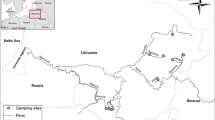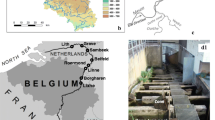Abstract
Back-calculated annual growth of 156 yellow-phase female Japanese eels Anguilla japonica sampled from freshwater sites in the Tsuchikawa River, Kagoshima, Japan, were compared among eels from the upper reaches (“upstream emigrants”), large eels (≥240 mm) from the lower reaches (“downstream residents”), and small eels (<240 mm) from the lower reaches (“undetermined”, including future emigrants and residents) to elucidate the possible relationships between growth conditions and habitat selection by Japanese eels. The youngest eels caught in the lower reaches were 1 year of age, whereas eels in the upper reaches were >3 years of age. Back-calculated annual growth of large eels captured in the lower reaches was significantly greater than that of eels in the upper reaches for the first 3 years after recruitment (age 0–2 years), and small eels in the lower reaches had intermediate growth. These results suggest that female eels in this river decide whether to emigrate or reside in the lower reaches approximately 3 years after recruitment, and that slower-growing eels emigrate upstream, whereas faster-growing eels reside downstream.




Similar content being viewed by others
References
Tsukamoto K (1992) Discovery of the spawning area for Japanese eel. Nature 356:789–791
Tsukamoto K, Chow S, Otake T, Kurogi H, Mochioka N, Miller MJ, Aoyama J, Kimura S, Watanabe S, Yoshinaga T, Shinoda A, Kuroki M, Oya M, Watanabe T, Hata K, Ijiri S, Kazeto Y, Nomura K, Tanaka H (2011) Oceanic spawning ecology of freshwater eels in the western North Pacific. Nat Commun 2:179
Kimura S, Tsukamoto K, Sugimoto T (1994) A model for the larval migration of the Japanese eel: roles of the trade winds and salinity front. Mar Biol 119:185–190
Kimura S, Doos K, Coward AC (1999) Numerical simulation to resolve the issue of downstream migration of the Japanese eel. Mar Ecol Prog Ser 186:303–306
Kaifu K, Tamura M, Aoyama J, Tsukamoto K (2010) Dispersal of yellow phase Japanese eels Anguilla japonica after recruitment in the Kojima Bay-Asahi River system, Japan. Environ Biol Fish 88:273–282
Gadgil M (1971) Dispersal: population consequences and evolution. Ecology 52:253–261
Tallman RF, Abrahams MV, Chudobiak DH (2002) Migration and life history alternatives in a high latitude species, the broad whitefish, Coregonus nasus Pallas. Ecol Freshw Fish 11:101–111
Morita K, Tamate T, Kuroki M, Nagasawa T (2014) Temperature-dependent variation in alternative migratory tactics and its implications for fitness and population dynamics in a salmonid fish. J Anim Ecol 83:1268–1278
Yokouchi K, Aoyama J, Oka HP, Tsukamoto K (2008) Variation in the demographic characteristics of yellow phase Japanese eels in different habitats of the Hamana Lake system, Japan. Ecol Freshw Fish 17:639–652
Kaifu K, Miller MJ, Yada T, Aoyama J, Washitani I, Tsukamoto K (2013) Growth differences of Japanese eels Anguilla japonica between fresh and brackish water habitats in relation to annual food consumption in the Kojima Bay-Asahi River system, Japan. Ecol Freshw Fish 22:127–136
Kaifu K, Yokouchi K, Miller MJ, Aoyama J, Tsukamoto K (2013) Head shape polymorphism in Japanese eels Anguilla japonica in relation to differences of somatic growth in fresh and brackish water habitats of the Kojima Bay-Asahi River system, Japan. J Fish Biol 82:1308–1320
Yokouchi K, Kaneko Y, Kaifu K, Aoyama J, Uchida K, Tsukamoto K (2014) Demographic survey of the yellow-phase Japanese eel Anguilla japonica in Japan. Fish Sci 80:543–554
Acou A, Lefebvre F, Contournet P, Poizat G, Panfili A, Crivelli AJ (2003) Silvering of female eels (Anguilla anguilla) in two sub-populations of the Rhone Delta. Bull Fr Pêche Piscic 368:55–68
Daverat F, Tomas J (2006) Tactics and demographic attributes in the European eel Anguilla anguilla in the Gironde watershed, SW France. Mar Ecol Prog Ser 307:247–257
Helfman GS, Bozeman EL, Brothers EB (1984) Size, age and sex of American eels in a Georgia river. Trans Am Fish Soc 113:132–141
Morrison WE, Secor DH (2003) Demographic attributes of yellow-phase American eels Anguilla rostrata in the Hudson River estuary. Can J Fish Aquat Sci 60:1487–1501
Tsukamoto K, Aoyama J, Miller MJ (2009) Status of the Japanese eel: resources and recent research. In: Casselman JM, Cairns DK (eds) Eels at the edge: science, status, and conservation concerns. American Fisheries Society, Symposium 58 Bethesda, Maryland, pp 21–35
Jacoby D, Gollock M (2014) Anguilla japonica. The IUCN Red List of Threatened Species. Version 2015.2. http://www.iucnredlist.org. Downloaded on 12 Aug 2015
Watanabe S, Aoyama J, Tsukamoto K (2004) Reexamination of Ege’s (1939) use of taxonomic characters of the genus Anguilla. Bull Mar Sci 74:337–351
Okamura A, Yamada Y, Yokouchi K, Horie N, Mikawa N, Utoh T, Tanaka S, Tsukamoto K (2007) A silvering index for the Japanese eel Anguilla japonica. Environ Biol Fishes 80:77–89
ICES (2009) Workshop on Age Reading of European and American Eel (WKAREA). ICES, Bordeaux
Kotake A, Arai T, Okamura A, Yamada Y, Utoh T, Oka HP, Miller MJ, Tsukamoto K (2007) Ecological aspects of Japanese eels, Anguilla japonica, collected from coastal areas of Japan. Zool Sci 24:1213–1221
Arai T, Kotake A, Ohji M, Miyazaki N, Tsukamoto K (2003) Migratory history and habitat use of Japanese eel Anguilla japonica in the Sanriku Coast of Japan. Fish Sci 69:813–818
Tsukamoto K, Arai T (2001) Facultative catadromy of the eel Anguilla japonica between freshwater and seawater habitats. Mar Ecol Prog Ser 220:265–276
Yokouchi K, Sudo R, Kaifu K, Aoyama J, Tsukamoto K (2009) Biological characteristics of silver-phase Japanese eels, Anguilla japonica, collected from Hamana Lake, Japan. Coast Mar Sci 33:54–63
Oliveira K (1999) Life history characteristics and strategies of the American eel, Anguilla rostrata. Can J Fish Aquat Sci 56:795–802
Tzeng WN, Lin HR, Wang CH, Xu SN (2000) Differences in size and growth rates of male and female migration Japanese eel in Pearl River, China. J Fish Biol 57:1245–1253
Campana SE (1990) How reliable are growth back-calculations based on otoliths? Can J Fish Aquat Sci 47:2219–2227
Fukuda N, Miller MJ, Aoyama J, Shinoda A, Tsukamoto K (2013) Evaluation of the pigmentation stages and body proportions from the glass eel to yellow eel in Anguilla japonica. Fish Sci 79:425–438
Imbert H, Labonne J, Rigaud C, Lambert P (2010) Resident and migratory tactics in freshwater European eels are size-dependent. Freshw Biol 55:1483–1493
Sang TK, Chang HY, Chen CT, Hui CF (1994) Population structure of the Japanese eel Anguilla japonica. Mol Biol Evol 11:250–260
Ishikawa S, Aoyama J, Tsukamoto K, Nishida M (2001) Population structure of the Japanese eel Anguilla japonica as examined by mitochondrial DNA sequencing. Fish Sci 67:246–253
Han YS, Hung CL, Tzeng WN (2010) Population genetic structure of the Japanese eel Anguilla japonica: panmixia at spatial and temporal scales. Mar Ecol Prog Ser 401:221–232
Minegishi Y, Aoyama J, Yoshizawa N, Tsukamoto K (2012) Lack of genetic heterogeneity in the Japanese eel based on a spatiotemporal sampling. Coast Mar Sci 35:269–276
Han YS, Iizuka Y, Tzeng WN (2010) Does variable habitat usage by the Japanese Eel lead to population genetic differentiation? Zool Stud 49:392–397
Smith JM (1972) On evolution. Edinburgh University Press, Edinburgh
Parker GA (1984) Evolutionarily stable strategies. In: Krebs JR, Davies NB (eds) Behavioural ecology, an evolutionary approach. Sinauer, Sunderland, pp 30–61
Gross MR (1991) Salmon breeding behavior and life history evolution in changing environments. Ecology 72:1180–1186
Vannote RL, Minshall GW, Cummins KW, Sedell JR, Cushing CE (1980) The river continuum concept. Can J Fish Aquat Sci 37:130–137
Tzeng WN, Cheng PW, Lin FY (1995) Relative abundance, sex ratio and population structure of the Japanese eel Anguilla japonica in the Tanshui River system of northern Taiwan. J Fish Biol 46:183–200
Author information
Authors and Affiliations
Corresponding author
Rights and permissions
About this article
Cite this article
Wakiya, R., Kaifu, K. & Mochioka, N. Growth conditions after recruitment determine residence-emigration tactics of female Japanese eels Anguilla japonica . Fish Sci 82, 729–736 (2016). https://doi.org/10.1007/s12562-016-1006-8
Received:
Accepted:
Published:
Issue Date:
DOI: https://doi.org/10.1007/s12562-016-1006-8




